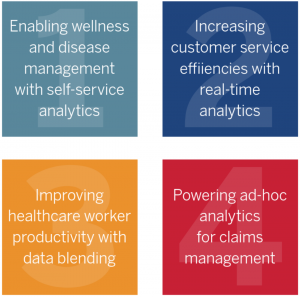As healthcare payer operations integrate new practices to align with the value-based care paradigm, payers are critically challenged with identifying root causes to solve issues in order to improve and sustain performance. BHM Healthcare Solutions play a critical role in a larger operational system and offers two resources for consideration when reviewing the larger payer operational landscape.
Andy Dé, Senior Industry Director for Healthcare and Life Sciences, for Tableau, released a solid report, How to Improve Healthcare Payer Operations with Data itemizing four ways payers can improve operations. Combining thoughts with a more thorough Oracle report, Improving Healthcare Payer Performance with Big Data and payers can move forward with a good foundation and plan.
Andy Dé’s Outline Of Four Basics Of Data Use:
Many healthcare payer organizations are transitioning from old business models to a new risk-based approach, and will need operational frameworks that enable monitoring, measuring, and continuous process improvement to help drive new revenue opportunities, lower costs, and better enable efficiencies. Along the way, organizations are discovering operational excellence simply isn’t possible without meaningful data insights.
Here are four ways leading healthcare payers are using data to modernize operations:
 Healthcare Payer Operations
Healthcare Payer Operations
1. Enabling Wellness and Disease Management with Self-Service Analytics
Self-service analytics allow healthcare payers to access and find insights from public health data sources like Medicare and Medicaid. These insights are used by healthcare payers to segment, target, and improve population health to drive wellness and disease management initiatives for their customers—who are patients.
By enabling anyone with the ability to explore public health data, any nurse case manager, analyst, business leader, or even a patient can see and understand the current state and risks associated with a portfolio of diseases.
2. Increasing Customer Service Efficiencies with Real-Time Analytics
Most healthcare payers offer web and mobile portals, as well as call centers, for customer service. However, most customers do not take the time to acquaint themselves with the capabilities of a self-service customer portal and choose to call a customer service representative instead. This common behavior generates higher demands on call centers for even trivial questions— which significantly increases the cost of operating the call centers, all the while the web and mobile portals remain underutilized.
3. Improving healthcare worker productivity with data blending
Healthcare payer organizations accumulate massive amounts of customer data that’s stored in silos across the entire enterprise. Connecting these islands of information is key to understanding a 360-degree view of each patient and their access to care. So the ability to aggregate and blend data across completely disparate data sources is key.
4. Powering ad-hoc analytics for claims management
Healthcare payers have to process millions of claims each year, and also screen these for fraud, waste, and abuse, which is often manual, tedious, time consuming, and fraught with human errors.
Conclusion
Monitoring, measuring, and analyzing healthcare payer data will improve operations by increasing employee productivity, lower costs, and enable a risk-based approach to wellness and disease management. It will also secure new customers and improve patient outcomes. Finding efficiencies in claims management, patient safety, and compliance with data is easier than you think—and integrating self-service data visualizations into your healthcare operations and processes is even easier.
